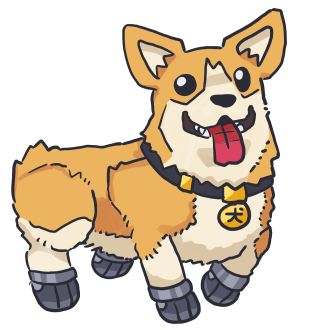Mama Bear is a modified Steelframe built by Horizon Adaptive Technologies Partnership for operation in heavy industrial work zones. Designed with large, robust joints and rounded protective shells, Mama Bear is both durable and easy to repair in remote locations far away from the comforts of a fully-stocked Steelframe hangar. It comes equipped with a wide-range frontal floodlight array and a 200° forcefield projection system, allowing Mama Bear to both light up and protect a dark and dangerous job site. Handrails and ladders allow crewmembers to climb on Mama Bear's exterior, enabling easier field maintenance and also allowing it to serve as supplemental scaffolding, watchtower highrise or other temporary support structures. Its back thruster has been modified to toggle between two modes- one is a standard mid-power ion thruster mode found on many Steelframes, while the other is an eco-friendly air recycling thruster which uses an intake of local atmospheric gas to drive its boosters, minimizing the output of pollutants that can come from typical thruster usage. A set of rear-mounted air-powered micro-thrusters and a matching set on each forearm allow Mama Bear to make small positional adjustments in zero-gravity environments, affording a handy bit of rotational precision to a Frame of this size. It's been given a custom coat of paint since its departure from the lumber industry, with a little face drawn on its head-mounted sensor array to better match its callsign. Tilly insisted on its inclusion.
As a large-size Steelframe, Mama Bear has a number of novel features that distinguish it from mid-size frames like Jackal or Stardiver. The main one, the most obvious one, is its wide, treaded feet. As an industrial Steelframe, Mama Bear operates primarily in sites with other workers underfoot, so when it is required to move through a populated area or it needs to make precise micro-adjustments on the positioning of an asteroid drill scaffold, it can use its treaded feet to move with care. Being able to move without lifting and lowering its enormous feet both minimizes collateral damage or worker incidents, and also allows it to move in centimeters rather than decameters. In its new life working in environmental conservation, these extra-wide feet distribute the considerable weight of its large chassis across more area and don't press as firmly into the soil below. It can also traverse ecologically-sensitive areas where the thump-thump-thump of its footfall might disturb local flora or subterranean fauna. Tilly has been known to rotate Mama Bear on its central axis using its treaded feet in order to give people using it as a lookout tower a better view of a different area. It's a nice option to have, to be able to make small movements rather than large ones, that is easy to overlook until your work calls for that utility. And of course, compared to other treaded industrial equipment, if Mama Bear does stumble into soft muddy terrain, it can simply lift its feet out of that mud with its own legs. That's a unique perk of hiring a Steelframe.
The other, less obvious feature of Mama Bear is its remarkable power output, and the degree of control it has over it. Its hands are well-articulated and very dexterous, enabling it to operate with delicate precision in handling creatures, objects, or in accurately deploying large-scale industrial equipment. Supplementing this dexterity is a set of high-torque gearbox motors on either side of its central cockpit, giving Mama Bear considerable lifting and pulling power even for its size. It can generate enough foot-pounds of force to cause significant damage to encroaching technological infrastructure, but still operate with the dexterity needed to carefully lift a scared or wounded animal and move it to safety. Recognizing the importance of lifting with your legs and not with your back, Mama Bear's hip joints are built with crouching, lifting and standing in mind, supporting those strong arms with a solid foundation beneath them. In gravity-rich environments, Mama Bear is well-equipped to move stone and steel alike, with a very wide range of power output profiles to serve a wide range of jobs, a quality reflecting its Martian heritage. Strength and precision, that's the running theme of Mama Bear's performance.
While Mama Bear originally deployed from a central base of operations, it is capable of operating in isolated locations for a considerable length of time. Its small movement capabilities, air recycling thruster and support scaffold utility allows it to be useful with very little power expenditure, enabling long-term base camps to be set up in locations it is deployed to. As a large-size Steelframe, it features a small living compartment in its huge central chassis, just below its main cockpit area. Closer to a pod than an apartment, the small space has a place to sit, lay down and watch TV comfortably for up to two people- while this feature was initially included for long-term industrial deployment scenarios, it does allow Tilly to use Mama Bear as a rescue and recovery vehicle as well. Lost, stranded or injured starfarers can be kept in Mama Bear's cabin pod, isolated from Tilly's cockpit area, where they can be transported safely through hazardous atmospheres or the void of space and delivered to the care they need. It's one of the perks of operating a large Steelframe, and while she's been known to set up a tent with the clients she works with, often times Tilly will choose to spend her nights on a long ecowatch mission nestled in Mama Bear's cabin. It's cramped, but it's cozy, and it reminds Tilly of the time she spent on the rig in the Asteroid Belt, tucking away in her quarters after a loud night of boasting, singing and drinking with the crew. While she's proud of the work she does these days, she does kinda miss the old boys, their stories and their songs.


